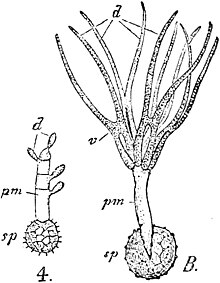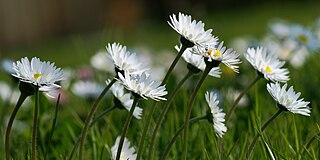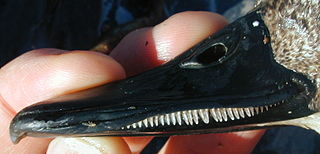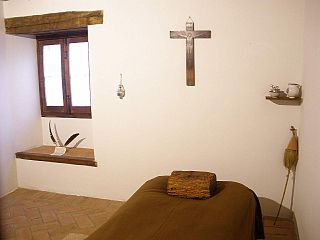This article relies largely or entirely on a single source .(October 2023) |

A gonidium (plural gonidia) is an asexual reproductive cell or group of cells, especially in algae. [1]
This article relies largely or entirely on a single source .(October 2023) |

A gonidium (plural gonidia) is an asexual reproductive cell or group of cells, especially in algae. [1]
Studies that are in vivo are those in which the effects of various biological entities are tested on whole, living organisms or cells, usually animals, including humans, and plants, as opposed to a tissue extract or dead organism. This is not to be confused with experiments done in vitro, i.e., in a laboratory environment using test tubes, Petri dishes, etc. Examples of investigations in vivo include: the pathogenesis of disease by comparing the effects of bacterial infection with the effects of purified bacterial toxins; the development of non-antibiotics, antiviral drugs, and new drugs generally; and new surgical procedures. Consequently, animal testing and clinical trials are major elements of in vivo research. In vivo testing is often employed over in vitro because it is better suited for observing the overall effects of an experiment on a living subject. In drug discovery, for example, verification of efficacy in vivo is crucial, because in vitro assays can sometimes yield misleading results with drug candidate molecules that are irrelevant in vivo.
In neuroanatomy, a plexus is a branching network of vessels or nerves. The vessels may be blood vessels or lymphatic vessels. The nerves are typically axons outside the central nervous system.
Webster's Dictionary is any of the English language dictionaries edited in the early 19th century by Noah Webster (1758–1843), an American lexicographer, as well as numerous related or unrelated dictionaries that have adopted the Webster's name in his honor. "Webster's" has since become a genericized trademark in the United States for English dictionaries, and is widely used in dictionary titles.

Merriam-Webster, Incorporated is an American company that publishes reference books and is especially known for its dictionaries. It is the oldest dictionary publisher in the United States.

Rheum is a thin mucus naturally discharged from the eyes, nose, or mouth, often during sleep. Rheum dries and gathers as a crust in the corners of the eyes or the mouth, on the eyelids, or under the nose. It is formed by a combination of mucus, nasal mucus, blood cells, skin cells, or dust.

In anatomy, the meninges are the three membranes that envelop the brain and spinal cord. In mammals, the meninges are the dura mater, the arachnoid mater, and the pia mater. Cerebrospinal fluid is located in the subarachnoid space between the arachnoid mater and the pia mater. The primary function of the meninges is to protect the central nervous system.
In biochemistry, a zymogen, also called a proenzyme, is an inactive precursor of an enzyme. A zymogen requires a biochemical change for it to become an active enzyme. The biochemical change usually occurs in Golgi bodies, where a specific part of the precursor enzyme is cleaved in order to activate it. The inactivating piece which is cleaved off can be a peptide unit, or can be independently-folding domains comprising more than 100 residues. Although they limit the enzyme's ability, these N-terminal extensions of the enzyme or a “prosegment” often aid in the stabilization and folding of the enzyme they inhibit.

In biology, a tropism is a phenomenon indicating the growth or turning movement of an organism, usually a plant, in response to an environmental stimulus. In tropisms, this response is dependent on the direction of the stimulus. Tropisms are usually named for the stimulus involved; for example, a phototropism is a movement to the light source, and an anemotropism is the response and adaptation of plants to the wind.
An inotrope or inotropic is a drug or any substance that alters the force or energy of muscular contractions. Negatively inotropic agents weaken the force of muscular contractions. Positively inotropic agents increase the strength of muscular contraction.

The metaphysis is the neck portion of a long bone between the epiphysis and the diaphysis. It contains the growth plate, the part of the bone that grows during childhood, and as it grows it ossifies near the diaphysis and the epiphyses. The metaphysis contains a diverse population of cells including mesenchymal stem cells, which give rise to bone and fat cells, as well as hematopoietic stem cells which give rise to a variety of blood cells as well as bone-destroying cells called osteoclasts. Thus the metaphysis contains a highly metabolic set of tissues including trabecular (spongy) bone, blood vessels, as well as Marrow Adipose Tissue (MAT).

In literature, an archenemy or archnemesis is the main enemy of someone. In fiction, it is a character who is the protagonist's, commonly a hero's, most prominent and most-known enemy.
An immunogen is any substance that generates B-cell (humoral/antibody) and/or T-cell (cellular) adaptive immune responses upon exposure to a host organism. Immunogens that generate antibodies are called antigens ("antibody-generating"). Immunogens that generate antibodies are directly bound by host antibodies and lead to the selective expansion of antigen-specific B-cells. Immunogens that generate T-cells are indirectly bound by host T-cells after processing and presentation by host antigen-presenting cells.

Leucism is a wide variety of conditions that result in the partial loss of pigmentation in an animal—causing white, pale, or patchy coloration of the skin, hair, feathers, scales, or cuticles, but not the eyes. It is occasionally spelled leukism. Some genetic conditions that result in a "leucistic" appearance include piebaldism, Waardenburg syndrome, vitiligo, Chédiak–Higashi syndrome, flavism, isabellinism, xanthochromism, axanthism, amelanism, and melanophilin mutations. Pale patches of skin, feathers, or fur can also result from injury.
Bruit, also called vascular murmur, is the abnormal sound generated by turbulent flow of blood in an artery due to either an area of partial obstruction or a localized high rate of blood flow through an unobstructed artery.

Keratosis is a growth of keratin on the skin or on mucous membranes stemming from keratinocytes, the prominent cell type in the epidermis. More specifically, it can refer to:

A pecten is a comb-like structure, widely found in the biological world. Although pectens in various animals look similar, they have a varied range of uses, from grooming and filtering to sensory adaptations.
Hemotherapy or hemotherapeutics is the treatment of disease by the use of blood or blood products from blood donation.

Merriam-Webster's Words of the Year are words of the year lists published annually by the American dictionary-publishing company Merriam-Webster, Inc. The lists feature ten words from the English language. These word lists started in 2003 and have been published at the end of each year.

A cell is a small room used by a hermit, monk, nun or anchorite to live and as a devotional space. Cells are often part of larger cenobitic monastic communities such as Catholic, Lutheran, Anglican and Orthodox Christian monasteries, as well as Buddhist vihara, but may also form stand-alone structures in remote locations. The word cell comes from the Old French celle meaning a monastic cell, itself from the Latin meaning "room", "store room" or "chamber".